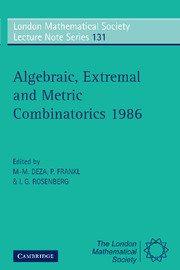Book contents
- Frontmatter
- Contents
- Introduction
- List of Talks
- Participants
- Some Recent Combinatorial Applications of Borsuk-Type Theorems
- On Extremal Finite Sets in the Sphere and Other Metric Spaces
- Metric and Geometric Properties of Sets of Permutations
- Infinite Geometric Groups and Sets
- Intersection and Containment Problems Without Size Restrictions
- Distance-Transitive Graphs of Valency k, 8 ≤ k ≤ 13
- Latin Square Determinants
- A Computer Search for a Projective Plane of Order 10
- Matroids, Algebraic and Non Algebraic
- Algebraic Properties of a General Convolution
- Quasi Groups, Association Schemes, and Laplace Operators on Almost Periodic Functions
- Geometric Methods in Group Theory
- Problem Section
Some Recent Combinatorial Applications of Borsuk-Type Theorems
Published online by Cambridge University Press: 05 April 2013
- Frontmatter
- Contents
- Introduction
- List of Talks
- Participants
- Some Recent Combinatorial Applications of Borsuk-Type Theorems
- On Extremal Finite Sets in the Sphere and Other Metric Spaces
- Metric and Geometric Properties of Sets of Permutations
- Infinite Geometric Groups and Sets
- Intersection and Containment Problems Without Size Restrictions
- Distance-Transitive Graphs of Valency k, 8 ≤ k ≤ 13
- Latin Square Determinants
- A Computer Search for a Projective Plane of Order 10
- Matroids, Algebraic and Non Algebraic
- Algebraic Properties of a General Convolution
- Quasi Groups, Association Schemes, and Laplace Operators on Almost Periodic Functions
- Geometric Methods in Group Theory
- Problem Section
Summary
INTRODUCTION
The well known theorem of Borsuk [Bo] is the following.
Theorem 1.1 (Borsuk)
For every continuous mapping f :Sn → Rn, there is a point x ϵ Sn such that f (x) = f (−x). In particular, if f is antipodal (i.e. f(x) = −f(−x) for all x ϵ Sn) then there is a point of Sn which maps into the origin.
This theorem and its many generalizations have numerous applications in various branches of mathematics, including Topology, Functional Analysis, Measure Theory, Differential Equations, Approximation Theory, Geometry, Convexity and Combinatorics. An extensive list of these applications, some of which are about fifty years old, appears in [Ste].
Most combinatorial applications of Borsuk's Theorem were found during the last ten years. The best known of these is undoubtfully Lovasz's ingenious proof of the Kneser conjecture. Kneser [Kn] conjectured in 1955 that if n ≥ 2r + t − 1 and all the r-subsets of an n-element set are colored by t colors then there are two disjoint r-sets having the same color. This was proved by Lovász twenty years later in [Lo]. Shortly afterwards, Bárány [Ba] gave a charming short proof. Both proofs apply Borsuk's theorem.
- Type
- Chapter
- Information
- Algebraic, Extremal and Metric Combinatorics 1986 , pp. 1 - 12Publisher: Cambridge University PressPrint publication year: 1988
- 4
- Cited by



